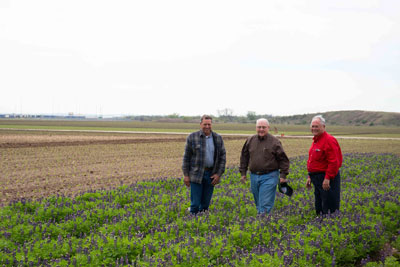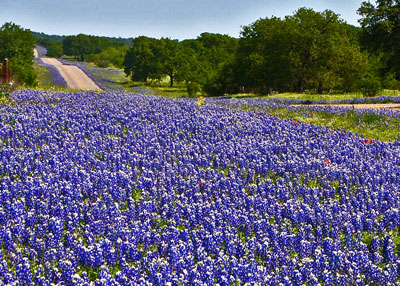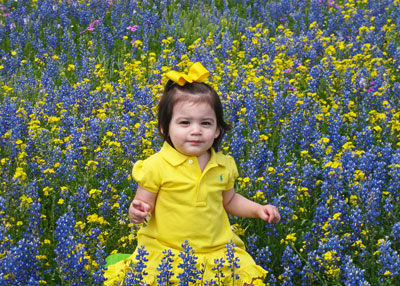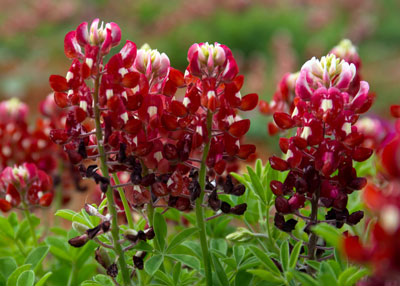Bluebonnets for Every Taste
Most bluebonnets are indeed blue. (I’ll try to make the rest of the story more informative.) But they do vary a lot in their appearance, even to the ones the gentleman was asking me about – the ones with very little white in their flower spikes.
I asked Dr. Jerry Parsons, who has spent years isolating and developing bluebonnets of all colors. I figured he would know if anyone did.

(L to R) TAMU Horticulture Dept. Head Dr. Larry Stein, Neil and Dr. Jerry Parsons, retired from the TAMU Extension Service, stand in a field of purple bluebonnets that Jerry has developed.
Turned out the answer was a lot simpler than I had expected. In fact, I should have known it. It’s a different species entirely.
Here is what Jerry wrote back:
“In the spring of 1901, the Texas Legislature got down to the serious business of selecting a state floral emblem, and the ensuing battle was hot and heavy. One legislator spoke emotionally in favor of the cotton boll, since cotton was king in Texas in those days.
Another, a young man from Uvalde, extolled the virtues of the cactus so eloquently, noting the hardy durability of the plant and the orchid-like beauty of its flowers, that he earned the nickname of “Cactus Jack” which stuck with him for the rest of his life. He was John Nance Garner, and he later became Vice President of the United States.
But the National Society of Colonial Dames of America in Texas won the day. Their choice was Lupinus subcarnosus (“generally known as buffalo clover or bluebonnet,” stated the resolution) and it was passed into law on March 7 without any recorded opposition.
And that’s when the polite bluebonnet war was started.
Lupinus subcarnosus is a dainty little plant that paints the sandy, rolling hills of coastal and southern Texas with sheets of royal blue in the early spring. But some folks thought it was the least attractive of the Texas bluebonnets. They wanted Lupinus texensis, the showier, bolder blue beauty that covers most of Texas and gives inspiration to many an artist.
So, off and on for 70 years, the Legislature was encouraged to correct its oversight. But the wise Solons of Capital Hill weren’t about to get caught in another botanical trap, nor did they want to offend the supporters of Lupinus subcarnosus. They solved the problem with typical political maneuvering.
In 1971, the Legislature handled the dilemma by adding the two species together, plus “any other variety of bluebonnet not heretofore recorded,” and lumped them all into one state flower.
Among the many things the Legislature did not know then was that the big state of Texas is home to three other species of Lupines, and the umbrella clause makes all five of them the state flower. And, if any new species are discovered, they automatically will assume the mantle of state flower as well.
• Lupinus subcarnosus, the original champion and still co-holder of the title, grows naturally in deep sandy loams from Leon County southwest to LaSalle County and down to the northern part of Hidalgo County in the Valley. It is often referred to as the sandy land bluebonnet. The plant’s leaflets are blunt, sometimes notched with silky undersides. This species, which reaches peak bloom in late March, is not easy to maintain in clay soils.
• Lupinus texensis, the favorite of tourists and artists, provides the blue spring carpet of Central Texas. It is widely known as the Texas bluebonnet. It has pointed leaflets, the flowering stalk is tipped with white (like a bunny’s tail), and it hits its peak bloom in late March and early April. It is the easiest of all the species to grow.”

Dr. Parsons’ photos quickly show the difference between
Lupinus texensis (top), with its white tips, and Lupinus subcarnosus,
below. (The yellow flowers, of course, are some other species.)

Dr. Parsons is not a Native Texan, having grown up in Memphis. But after achieving his PhD and joining the TAMU Extension Service system in the early 1970s (when I met him), he served our state for all of his career. He continues to do so, with one of his “retirement” hobbies being purification of colors within the bluebonnet fields in his research plots. It began with his seeking a “true red” bluebonnet that could be included in a planting to make the Texas state flag entirely from bluebonnets. He’s come pretty close I would say!

Some artists are never satisfied with their works, always striving to make them better. Jerry Parsons may be that way in his quest for red bluebonnets, but most of us think he’s already there. Great work, good friend!
No one ever says the name “Jerry Parsons” among horticulturists without getting a smile back. We all admire Jerry for all that he does. But this time of year, especially the bluebonnets.
Here is Jerry’s extensive “plantanswers” website.
